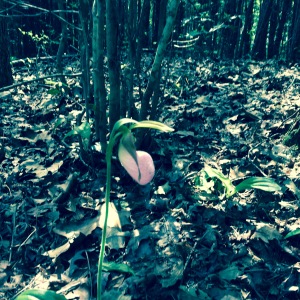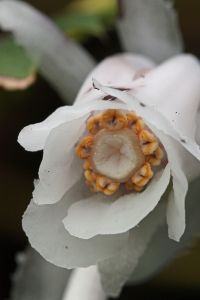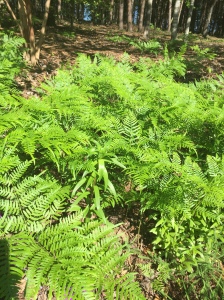
Lady Slipper Orchid
When Martin and I bought our property thirteen years ago, it was so thick with wild blackberry brambles, honeysuckle, poison ivy and Muscatine grape vines, we were unable to step more than a few feet into it from the road. The aerial photo on the county records site wasn’t much help either. Beyond the clogged meadow at the road frontage thousands of pine trees hid any view of the rest of the property. We bought it anyway. At the time I was working as a real estate broker. I knew wooded properties were few and far between.
From the road we could also see mature oaks, hickory, maples, poplar and beech. We sited the house right smack in the middle of the six acres for privacy. When our builder cleared a path for the drive and started building, we started spending weekends clearing the brush and pines. I wasn’t much of a conservationist then. Still, it was low tech clearing with loppers, pruners and hand saws. Our builder didn’t burn debris; he had it hauled away. Using hand tools as our ancestors would have, Martin and I cleared enough to fill two dump trucks!

Ghost Pipe
During the nine months of building and clearing, we made many discoveries. I remember the late March day I walked up the drive to see the white flowers of dozens of dogwoods welcoming spring. As spring advanced we found wildflowers popping up everywhere _ pink lady slipper orchids, crested iris, yellow loosestrife, Solomon’s seal and many more I didn’t recognize. I bought a book on wildflowers of the Southeastern United States. There were ground covers like wild ginger, partridge-berry and coral berry. Summer brought milkweed and butterfly weed. The strange looking ghost pipes made an appearance. Fall brought the orange berries of hearts a burstin’.

Hearts a Burstin’
With these discoveries the property took on new meaning. I felt like we needed to conserve the wild things. Thus came the decision not to allow any further heavy equipment on the property. No bulldozers or backhoes to remove the onerous pines.
By now we also realized something was wrong with the pines. Clemson University Extension agents helped us identify two types of pines beetles gnawing their way through the woods. They are also Virginia pines, which do not fare so well this far south. Planted decades ago as a relatively quick money crop, now too dense, many are diseased. Our woods were declared as unhealthy. Chainsaws were purchased to make the job of removing them easier, but we still have thousands of them. Because of the pests and disease, they have to be burned. It is an arduous task. It is also a labor of love.
We made paths over the years, clearing out the old logging trails, and can now walk through most of the six acres. There are two fields of rocks across the upper ridge, rocks large enough to sit upon and contemplate the emerging beauty of the woods. Mountain laurel will bloom in May along the back path. June will bring a show of creamy panicles on the sourwood trees as bees work them to produce what some claim is the best honey in the world.
The more we clear the pines, the more the sun finds the earthen floor of the woods, the more the wild things spread to feed some animal. In recent years, we’ve had a bear appear, probably in search of the huckleberries growing wild beneath the trees. The raccoons, opossums, skunks and fox have been here all along. There are plenty of squirrels and chipmunks. An owl hoots all night long in the woods behind the house.

Native ferns fill in my hillside garden
In the landscaped gardens surrounding the house, much to my delight, many of the wild plants have invaded. Wild ferns fill the sunny hillside off the screen porch. Solomon’s seal dots the shaded hillside to the front of the house. Red flowered trillium showed up in the side garden a couple of years ago and continues to spread.
I try to be a good steward of what has been given to me. It is not always easy. But, as I watched the first hummingbird of the season flit through the garden and woods last week, I remind myself this is why the wild things must continue to grow.
Let’s make every day Earth Day!

Kathy, I couldn’t agree with you more. We have 120 acres of timber here in Idaho, and believe passionately that a well managed forest is a healthy forest. Your post makes an excellent case!
LikeLike
You are indeed blessed to have such a home and wild flowers are a bonus as some of us must be content in admiring these from afar!
Sent from my iPad
LikeLike
Lovely photos and so interesting to read about your property! paradise for you!
LikeLike
Beautiful – a treasure trove in the woods!
LikeLike
Great post…made more indelible by my memories of wandering around the gardens with you…or chatting with one of the plants you gave me as it bursts into bloom in my gardens
LikeLike
Lovely flowers! I had never heard of ghost pipes or hearts a burstin, but they are beautiful. I love seeing all the different flora and fauna found around the country – and the world!
LikeLike
A lovely reminiscence of the years spent caring for your property. I’m with you about stewardship. I, too, have six acres, and realize that it is only “mine” for a few short years, and when I’m gone, the property will still be here. I hope that someone else who appreciates the wild flowers, wild raspberries, wild grapes, beautiful maples, etc., will care for it after me.
Rin
LikeLike
Thank you very much, nice to contemplate with.
LikeLike
Thank you for sharing Kathy, a labour of love indeed. We thought we had taken on a lot buying 2 cleared acres and establishing native gardens. Almost the reverse of your task and on a smaller scale. Still a lot of work, but the increasing variety of birds which are appearing are a daily reminder that it was worth it.
LikeLike
This is such a lovely and heartfelt ode to the wonders of the natural world. Thanks for this Earth Day tribute.
LikeLike